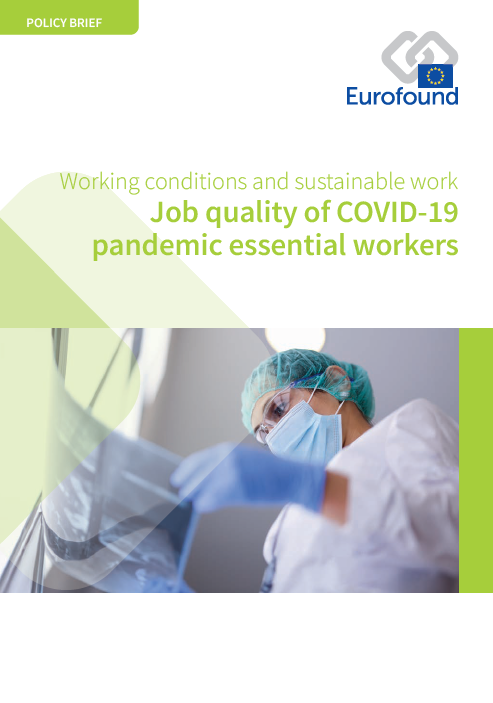
Pendant la pandémie de COVID-19, un ensemble diversifié de travailleurs ont assuré le fonctionnement de nos sociétés. Dans une période de crise, ils ont maintenu l’accès aux soins de santé, aux soins de longue durée et aux autres biens et services essentiels, y compris la nourriture, l’eau, l’électricité, l’internet et le traitement des déchets. Ces travailleurs, qui se sont avérés essentiels ou critiques pendant la pandémie de COVID-19, ont pour beaucoup risqué leur santé physique et mentale en continuant à travailler aussi longtemps qu’a duré la crise sanitaire.
Cette note d’orientation porte sur la qualité de l’emploi de ces travailleurs critiques, en utilisant des sources d’information uniques, notamment les données de l’enquête européenne sur les conditions de travail 2021, les données recueillies par divers correspondants dans les États membres et les entretiens menés auprès des représentants des partenaires sociaux au niveau de l’UE dans les secteurs retenus. Elle examine les expériences de travail des travailleurs critiques pendant la pandémie et met en lumière les défis imminents pour la durabilité de leur travail. L’objectif est de déterminer si ces travailleurs disposent des moyens nécessaires pour soutenir la société pendant les chocs et les crises futurs.
Key findings
- Health and care workers, food system workers, cleaners and refuse workers, transport workers, manual workers, and protective services workers are essential workers whose health and well-being were at risk during the COVID-19 pandemic. That risk continues post-pandemic because of poor job quality and the weaker sustainability of the work practices they experience. If this is not addressed, it will exacerbate existing labour shortages, which in turn will reduce the capacity of societies to function and benefit from quality services in the future.
- During the COVID-19 pandemic, policy measures to support critical workers did not cover all of them, excluding groups less visible and not on the frontline. Critical workers across all occupations need to be recognised and supported, especially in times of crisis.
- Critical occupations that are currently suffering from labour shortages, such as jobs in health and care, can be made more attractive to workers by improving job quality and bringing their pay into line with their value to society. The EU’s capacity to deal with future shocks, crises and polycrises while navigating the demographic, digital and green transitions will depend greatly on the conditions under which critical workers will be able to perform their work.
- Staff shortages or unattractive jobs are considered key challenges by at least one side of industry in five critical sectors: hospitals and healthcare; education; food and drinks; industrial cleaning; and local and regional government. Difficult working conditions were mentioned as one of the main causes of these challenges.
- Many groups of critical workers work in occupations and sectors are highly imbalanced in terms of gender. The improvement of job quality and the development of sustainable work practices is key to supporting the creation of a more diverse workforce and enlarging the pool of potential workers.
The policy brief contains the following lists of tables and figures.
List of tables
- Table 1 (part 1): Summary of sociodemographic characteristics of critical worker groups
- Table 1 (part 2): Summary of sociodemographic characteristics of critical worker groups
- Table 2: Sectoral challenges in the wake of the COVID-19 pandemic identified by sectoral social partners
List of figures
- Figure 1: Share of critical workers, EU and Member States, 2021 (%)
- Figure 2: Distribution of critical workers according to group
- Figure 3: Women as a share of critical worker groups, EU, 2021 (%)
- Figure 4: Place of work of critical workers, EU, 2021 (%)
- Figure 5: Job quality index, by critical worker group, EU, 2021 (%)
- Figure 6: Job demands, by critical worker group, EU, 2021 (index 0–100)
- Figure 7: Handling or being in contact with infectious materials, EU, 2021 (%)
- Figure 8: Physical demands, EU, 2021 (%)
- Figure 9: Exposure to adverse social behaviour, EU, 2021 (%)
- Figure 10: Work intensity, EU, 2021 (%)
- Figure 11: Unsocial work schedules, EU, 2021 (%)
- Figure 12: Possibility of losing one’s job within six months, EU, 2021 (%)
- Figure 13: Job resources, by critical worker group, EU, 2021 (index 0–100)
- Figure 14: Social support at work, EU, 2021 (%)
- Figure 15: Task discretion and autonomy, EU, 2021 (%)
- Figure 16: Organisational participation, EU, 2021 (%)
- Figure 17: Flexibility in working hours, EU, 2021 (%)
- Figure 18: Training provided or paid for by the employer, EU, 2021 (%)
- Figure 19: Intrinsic rewards, EU, 2021 (%)
- Figure 20: Economic hardship, EU, 2021 (%)
- Figure 21: Employees without formal employee representation in the workplace, EU, 2021 (%)
- Figure 22: Levels of work engagement, EU, 2021 (%)
- Figure 23: Health and safety at risk because of work, EU, 2021 (%)
- Figure 24: Risk of burnout, EU, 2021 (%)
- Number of pages
-
36
- Reference nº
-
EF23003FR
- ISBN
-
978-92-897-2366-4
- Catalogue nº
-
TJ-AR-23-002-FR-N
- DOI
-
10.2806/197098
- Permalink
Cite this publication
Eurofound (2023), Job quality of COVID-19 pandemic essential workers, European Working Conditions Telephone Survey series, Publications Office of the European Union, Luxembourg.